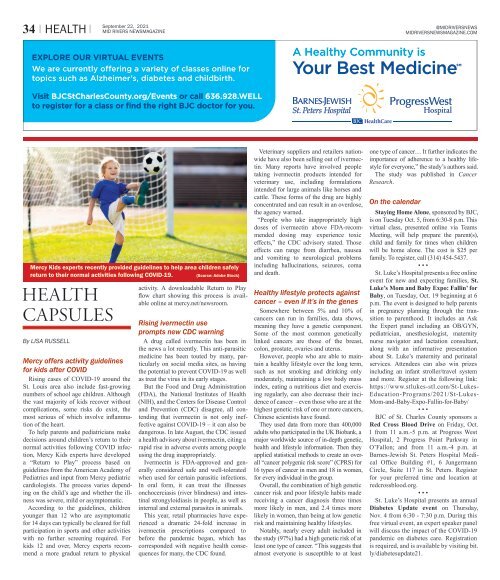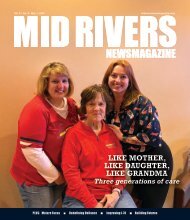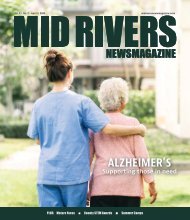Mid Rivers Newsmagazine 9-22-21
Local news, local politics and community events for St. Charles County Missouri.
Local news, local politics and community events for St. Charles County Missouri.
Create successful ePaper yourself
Turn your PDF publications into a flip-book with our unique Google optimized e-Paper software.
34 I HEALTH I<br />
September <strong>22</strong>, 20<strong>21</strong><br />
MID RIVERS NEWSMAGAZINE<br />
@MIDRIVERSNEWS<br />
MIDRIVERSNEWSMAGAZINE.COM<br />
Mercy Kids experts recently provided guidelines to help area children safely<br />
return to their normal activities following COVID-19.<br />
(Source: Adobe Stock)<br />
health<br />
capsules<br />
By LISA RUSSELL<br />
Mercy offers activity guidelines<br />
for kids after COVID<br />
Rising cases of COVID-19 around the<br />
St. Louis area also include fast-growing<br />
numbers of school age children. Although<br />
the vast majority of kids recover without<br />
complications, some risks do exist, the<br />
most serious of which involve inflammation<br />
of the heart.<br />
To help parents and pediatricians make<br />
decisions around children’s return to their<br />
normal activities following COVID infection,<br />
Mercy Kids experts have developed<br />
a “Return to Play” process based on<br />
guidelines from the American Academy of<br />
Pediatrics and input from Mercy pediatric<br />
cardiologists. The process varies depending<br />
on the child’s age and whether the illness<br />
was severe, mild or asymptomatic.<br />
According to the guidelines, children<br />
younger than 12 who are asymptomatic<br />
for 14 days can typically be cleared for full<br />
participation in sports and other activities<br />
with no further screening required. For<br />
kids 12 and over, Mercy experts recommend<br />
a more gradual return to physical<br />
activity. A downloadable Return to Play<br />
flow chart showing this process is available<br />
online at mercy.net/newsroom.<br />
Rising ivermectin use<br />
prompts new CDC warning<br />
A drug called ivermectin has been in<br />
the news a lot recently. This anti-parasitic<br />
medicine has been touted by many, particularly<br />
on social media sites, as having<br />
the potential to prevent COVID-19 as well<br />
as treat the virus in its early stages.<br />
But the Food and Drug Administration<br />
(FDA), the National Institutes of Health<br />
(NIH), and the Centers for Disease Control<br />
and Prevention (CDC) disagree, all contending<br />
that ivermectin is not only ineffective<br />
against COVID-19 – it can also be<br />
dangerous. In late August, the CDC issued<br />
a health advisory about ivermectin, citing a<br />
rapid rise in adverse events among people<br />
using the drug inappropriately.<br />
Ivermectin is FDA-approved and generally<br />
considered safe and well-tolerated<br />
when used for certain parasitic infections.<br />
In oral form, it can treat the illnesses<br />
onchocerciasis (river blindness) and intestinal<br />
strongyloidiasis in people, as well as<br />
internal and external parasites in animals.<br />
This year, retail pharmacies have experienced<br />
a dramatic 24-fold increase in<br />
ivermectin prescriptions compared to<br />
before the pandemic began, which has<br />
corresponded with negative health consequences<br />
for many, the CDC found.<br />
Veterinary suppliers and retailers nationwide<br />
have also been selling out of ivermectin.<br />
Many reports have involved people<br />
taking ivermectin products intended for<br />
veterinary use, including formulations<br />
intended for large animals like horses and<br />
cattle. These forms of the drug are highly<br />
concentrated and can result in an overdose,<br />
the agency warned.<br />
“People who take inappropriately high<br />
doses of ivermectin above FDA-recommended<br />
dosing may experience toxic<br />
effects,” the CDC advisory stated. Those<br />
effects can range from diarrhea, nausea<br />
and vomiting to neurological problems<br />
including hallucinations, seizures, coma<br />
and death.<br />
Healthy lifestyle protects against<br />
cancer – even if it’s in the genes<br />
Somewhere between 5% and 10% of<br />
cancers can run in families, data shows,<br />
meaning they have a genetic component.<br />
Some of the most common genetically<br />
linked cancers are those of the breast,<br />
colon, prostate, ovaries and uterus.<br />
However, people who are able to maintain<br />
a healthy lifestyle over the long term,<br />
such as not smoking and drinking only<br />
moderately, maintaining a low body mass<br />
index, eating a nutritious diet and exercising<br />
regularly, can also decrease their incidence<br />
of cancer – even those who are at the<br />
highest genetic risk of one or more cancers,<br />
Chinese scientists have found.<br />
They used data from more than 400,000<br />
adults who participated in the UK Biobank, a<br />
major worldwide source of in-depth genetic,<br />
health and lifestyle information. Then they<br />
applied statistical methods to create an overall<br />
“cancer polygenic risk score” (CPRS) for<br />
16 types of cancer in men and 18 in women,<br />
for every individual in the group.<br />
Overall, the combination of high genetic<br />
cancer risk and poor lifestyle habits made<br />
receiving a cancer diagnosis three times<br />
more likely in men, and 2.4 times more<br />
likely in women, than being at low genetic<br />
risk and maintaining healthy lifestyles.<br />
Notably, nearly every adult included in<br />
the study (97%) had a high genetic risk of at<br />
least one type of cancer. “This suggests that<br />
almost everyone is susceptible to at least<br />
one type of cancer… It further indicates the<br />
importance of adherence to a healthy lifestyle<br />
for everyone,” the study’s authors said.<br />
The study was published in Cancer<br />
Research.<br />
On the calendar<br />
Staying Home Alone, sponsored by BJC,<br />
is on Tuesday Oct. 5, from 6:30-8 p.m. This<br />
virtual class, presented online via Teams<br />
Meeting, will help prepare the parent(s),<br />
child and family for times when children<br />
will be home alone. The cost is $25 per<br />
family. To register, call (314) 454-5437.<br />
• • •<br />
St. Luke’s Hospital presents a free online<br />
event for new and expecting families, St.<br />
Luke’s Mom and Baby Expo: Fallin’ for<br />
Baby, on Tuesday, Oct. 19 beginning at 6<br />
p.m. The event is designed to help parents<br />
in pregnancy planning through the transition<br />
to parenthood. It includes an Ask<br />
the Expert panel including an OB/GYN,<br />
pediatrician, anesthesiologist, maternity<br />
nurse navigator and lactation consultant,<br />
along with an informative presentation<br />
about St. Luke’s maternity and perinatal<br />
services. Attendees can also win prizes<br />
including an infant stroller/travel system<br />
and more. Register at the following link:<br />
https://www.stlukes-stl.com/St-Lukes-<br />
Education-Programs/20<strong>21</strong>/St-Lukes-<br />
Mom-and-Baby-Expo-Fallin-for-Baby/<br />
• • •<br />
BJC of St. Charles County sponsors a<br />
Red Cross Blood Drive on Friday, Oct.<br />
1 from 11 a.m.-5 p.m. at Progress West<br />
Hospital, 2 Progress Point Parkway in<br />
O’Fallon; and from 11 a.m.-4 p.m. at<br />
Barnes-Jewish St. Peters Hospital Medical<br />
Office Building #1, 6 Jungermann<br />
Circle, Suite 117 in St. Peters. Register<br />
for your preferred time and location at<br />
redcrossblood.org.<br />
• • •<br />
St. Luke’s Hospital presents an annual<br />
Diabetes Update event on Thursday,<br />
Nov. 4 from 6:30 - 7:30 p.m. During this<br />
free virtual event, an expert speaker panel<br />
will discuss the impact of the COVID-19<br />
pandemic on diabetes care. Registration<br />
is required, and is available by visiting bit.<br />
ly/diabetesupdate<strong>21</strong>.

















